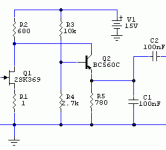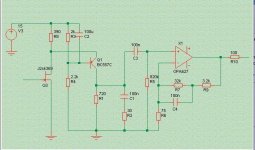I do not understand 100%. A folded cascode could be an alternative. It could have more gain as an advantage. Disadvantages are that 16.5V has to develop over the collector resistors of the input BJT cascodes for maximum dynamic range and the current of the input stage plus the current of the folded cascodes have to flow in that resistor. Contrast that to my mirror. It looses only 3 x Vbe plus the loss in the emitter resistors. Let´s assume they are 150 Ohm and 28mA flows in the input stage ( 4 plus 4 2SK170BL , 2SJ74BL ). That amounts to 6.15V and only 28mA is flowing in both legs of the mirror.
Ricardo, here is a first attempt on dimensioning the circuit.
Ricardo, here is a first attempt on dimensioning the circuit.
Attachments
So Jan you could do the layout and Michael do the simulation ? Then we would have something like the official MPP DIY version. A PSU has to be developed too. I could make a suggestion . Another option would be to use the Jung - Didden regulator that Pilgham Audio makes. Ricardo i will fill in some values but they have to be checked. Especially the servo is not that easy because it will influence the deeper frequency range of the RIAA. The input stage has some thermal drift. After adjusting the 10 Ohm pot i get around plus - minus 1V over the RIAA. If we make the Servo too quick it will influence the RIAA more then necessary, if we make it too slow we end up with a drifting offset. Earlier i solved that with a cap in front of the buffer but then Vds of the input Fets floats around. With the servo we can adjust the 10 Ohm pot for minimal distortion and still get less then 1mV offset.
Joachim,
A nice servo trick is to connect both the sense and force connections of the servo to the same point, the output. It's like the servo nulls it's own input and there is no impact on the rest of the circuit.
I've used it a few times and even if it looks funny it works great!
I'll put a small diagram together for later.
Edit: attached
jan
Attachments
Last edited:
I do not understand 100%. A folded cascode could be an alternative. It could have more gain as an advantage. Disadvantages are that 16.5V has to develop over the collector resistors of the input BJT cascodes for maximum dynamic range and the current of the input stage plus the current of the folded cascodes have to flow in that resistor. Contrast that to my mirror. It looses only 3 x Vbe plus the loss in the emitter resistors. Let´s assume they are 150 Ohm and 28mA flows in the input stage ( 4 plus 4 2SK170BL , 2SJ74BL ). That amounts to 6.15V and only 28mA is flowing in both legs of the mirror.
Because there is a drop to be developed over a resistor if to go folded, sizing that resistor for given psus and not much Vds to avoid Ig, its either enough loading value and reduced current or small loading value and more current. When going telescopic cascode with mirror CCS you can afford Id near Idss with no resistor sizing compromises, you can allow more standing current to drive the passive part of the filter load. I asked to understand if you thought of that and preferred the telescopic, since enough PSRR can be had by the mirrors already. Or for some other reason.
Ricardo, why not a Salas Shunt ? The only problem can be oscillation.
Oscilation ? why is that ?
Salas, instead of the resistor for the folded cascode a constant current source could be used. That drives up the gain even more. I build circuits like that that worked. I do not know why but i fell more comfortable with my current mirror solution. It would be nice if you could draw a circuit that illustrates your point. I am more of a visual type you know.
Instead of my current mirror one could use a mirror with cacodes. That is different from the
cascoded mirror or the enhanced Wilson i use. In fact there are nearly infinite possibilities to make a precision mirror.
Instead of my current mirror one could use a mirror with cacodes. That is different from the
cascoded mirror or the enhanced Wilson i use. In fact there are nearly infinite possibilities to make a precision mirror.
Self-servo attached. What this does is to servo out the offset at the output (at your terminal VF2) without injecting anything upstream.
Maybe you or anyone else can add that to the simulation to verify. The servo RC should be the usual 1megohm and 1uF; the resitor going back to VF2 should be tried out; depends on the Zout of your circuit.
jan didden
Maybe you or anyone else can add that to the simulation to verify. The servo RC should be the usual 1megohm and 1uF; the resitor going back to VF2 should be tried out; depends on the Zout of your circuit.
jan didden
Attachments
Salas, instead of the resistor for the folded cascode a constant current source could be used. That drives up the gain even more.
Using mirror source, 3 active cells again but folded. Should be equivalent in complexity level to what you now use, beyond more gain burning into feedback that may be or may be not desired.
It would be nice if you could draw a circuit that illustrates your point. I am more of a visual type you know.
*Schematically lets see Werner's folded cell for instance I redraw to show. 1.7mA in this one available to drive the passive part (low time constant). A bit more, can go 2-3mA depends on gain target, PSU etc. But what runs through Q1 is much more and could be available with a telescopic cascode. Losing PSRR VS folded, but getting it back if with CCS mirror load.
Attachments
Do i understand that correctly ? There is only 2-3mA to drive the Transimpedance RIAA ?
P.S. 2.79mA for R1, 7V across Q1 and 9V across a 12mA IDSS K369 Q3 to be exact, I found the original and just run its values.
Attachments
A direct folded cascode like Werners has too little drive voltage to steer an AIOG RIAA with good overload margin.
That may be the reason he only does the 75usec part that way and does the rest in the second stage. The Summer 2011 MPP could be done as a too stage too. See the schematic.
But i decided on a one stage approach.
That may be the reason he only does the 75usec part that way and does the rest in the second stage. The Summer 2011 MPP could be done as a too stage too. See the schematic.
But i decided on a one stage approach.
Attachments
The Summer 2011 MPP could be done as a too stage too. See the schematic.
But i decided on a one stage approach.
Yes, but you got enough dynamic first stage to cope with load, so you decided well IMHO.
The Summer 2011 MPP could be done as a too stage too. See the schematic.
Another thing I have seen with split Riaa and active high part in OP Fb loop is its very very much exact values sensitive when enough gain is allocated (normally). Difficult not to have bumps and valleys in an average parts selection build for tolerance and no FR FFT check, good LCR for matching etc.

